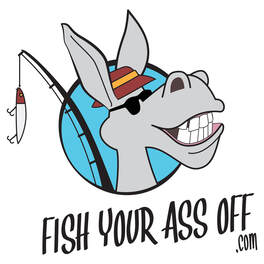
Can you catch flounder in the Winter?
Yes, you can catch flounder in the winter months but you will have to target them offshore or around near shore structure. Flounder move out into the Gulf of Mexico and the Atlantic Ocean in the winter to spawn so you might have to go offshore 30 or 40 miles to find them during the cooler months.
Florida is lucky because our water temperatures don't get too low and many flounder can still be caught around the inlets and passes during the winter months.
We are also lucky because we have two flounder species that we can target. There is the Gulf Flounder and the Southern Flounder. The Gulf Flounder is smaller and only has 3 eye spots on its back and the Southern Flounder is larger and has many eye spots on its back. That is how you can tell the difference between the two species.
Most flounders will move offshore to spawn but many can still be caught nearshore on reefs and wrecks off of the beach in Florida. The key is to find some near shore structure where the flounder might be hanging out.
The author of this article is a FISHING CHARTER CAPTAIN. He has been fishing for flounders in the grass flats, oyster bars and mangroves all over Florida for more than 40 years.
In the article below, we will talk about how to catch flounder in the winter; where to catch flounder in the winter; and the best baits and lures to catch flounder in the winter.
Let's get started.
Watch the video below to learn how to catch flounder in the Winter.
Yes, you can catch flounder in the winter months but you will have to target them offshore or around near shore structure. Flounder move out into the Gulf of Mexico and the Atlantic Ocean in the winter to spawn so you might have to go offshore 30 or 40 miles to find them during the cooler months.
Florida is lucky because our water temperatures don't get too low and many flounder can still be caught around the inlets and passes during the winter months.
We are also lucky because we have two flounder species that we can target. There is the Gulf Flounder and the Southern Flounder. The Gulf Flounder is smaller and only has 3 eye spots on its back and the Southern Flounder is larger and has many eye spots on its back. That is how you can tell the difference between the two species.
Most flounders will move offshore to spawn but many can still be caught nearshore on reefs and wrecks off of the beach in Florida. The key is to find some near shore structure where the flounder might be hanging out.
The author of this article is a FISHING CHARTER CAPTAIN. He has been fishing for flounders in the grass flats, oyster bars and mangroves all over Florida for more than 40 years.
In the article below, we will talk about how to catch flounder in the winter; where to catch flounder in the winter; and the best baits and lures to catch flounder in the winter.
Let's get started.
Watch the video below to learn how to catch flounder in the Winter.
How do you catch flounder in the Winter?
Flounder can be caught in the winter months but you have to head offshore to wrecks, reefs and any other structure to find the fish. Most of the larger flounder will head offshore in the Winter in order to spawn.
You can sometimes ambush them in the inlets and passes as they filter out from the inshore tidal creeks and estuaries and make their way to the Gulf of Mexico and the Atlantic Ocean. The problem is that you never know when they will start moving through.
One day they might not be there and then the next there might be dozens that you can catch. The mass exodus from inshore to offshore happens in the late Fall usually. You just have to put some serious fishing time to know when the flounder are making their move to deeper water.
I created an entire FREE online fishing course all about catching flounder that you can access on this website. You can see this flounder fishing course by clicking right here.
The key to catching flounder is knowing their traits and habits. Know this one for sure. FLOUNDER WILL NOT CHASE BAITS VERY FAR FROM THEIR AMBUSH POINTS.
When you see videos of a flatfish aggressively chasing a lure for many yards, you are actually seeing a fluke. Flukes are much more aggressive than Southern and Gulf Flounder species.
You have to get your bait or lure within 3 or 4 feet of a flounder to get it to break its cover and chase your offering. This means that you will have to very methodically fish an area to make sure that there are not any flounder there before you move to find another spot.
PRO TIP- It is very hard to know when a flounder has your lure in its mouth. They are subtle strikers so when you feel like you have hooked the bottom or some grass set that hook. They won't usually hold onto a lure for very long before they spit it out.
Live bait is a different story. When you think that a flounder has grabbed your live bait offering give it a 3 count before setting the hook. They will often hold onto the fish a second or two before swallowing it.
What are the best baits and lures for catching flounder in the Winter?
The key to catching flounder in the Winter months offshore is heavier baits and lures. You might be fishing in 60 or 70 feet of water for flounder in Winter so you will need heavier weights and jigs.
LURES
Flounder really like light colored lures like white and chartreuse. My go to colors are white soft plastics with a chartreuse jig head.
An example might be a pearl colored 4 inch Berkeley Gulp shrimp with a 3/8 ounce chartreuse jig head. The body doesn't have to be white either. You can use an all chartreuse jerk shad or something equivalent.
PRO TIP- Flounder like larger profiles like a 5 or 6 inch jerk bait or paddle tail type of soft plastic. Flounders actually have a large mouth that can eat very large fish. Larger lures will often lead to you catching larger sized flounders too.
The key to flounder fishing is getting your lures in their strike zones. You have to be within a foot of the bottom and within 3 or 4 feet of where they are hiding to really get their attention.
I wrote another article on this website all about the best Berkeley Gulp Baits for catching flounder and other species of inshore fish. You can see that article by clicking right here.
If you don't want to use Berkeley products then you can add a piece of fish bites to your jigs. They are smelly strips that come in shrimp, sand flea, clam scents and many others. The bottom line is that scented baits get more bites than unscented baits.
Many flounder pounders still use the age old bucktail jigs. These jigs are made of deer tail fur and a lead jig head. This old time favorite for many flounder fisherman has always worked and will always work for catching flounder in the winter.
You can basically drag these lures on the bottom and catch flounder but if you bounce them a foot off of the bottom you will have much better results. You have to get those flounder to break cover and chase your lures.
An active lure presentation is the best way to get flounders to bite your bucktail jig.
They are much more apt to do that if your lure is bouncing off of the bottom and fluttering back down every few feet.
WANT TO CATCH FLOUNDER? BOOK YOUR FISHING CHARTER TODAY!
LIVE BAIT
Flounders love live bait too. You have to remember that flounder are fish eaters. Yes, they will eat a crab or a shrimp if it comes too close to them but they prefer fish.
A finger mullet with a sliding weight above it is a great way to catch flounders when they are near offshore structure. Just sink your mullet, sardine, menhaden, pinfish, grunt........ down to the edges of the the structure and start catching flounder if they are there.
This type of rig is called a knocker rig and it is a great way to fish with live bait when the flounder are moving through the inlets in your area.
Another great live bait rig to catch flounder in the winter months is a dropper loop. In this type of presentation, your weight is on the bottom and your live bait offering is 6 to 12 inches above it extending out from your main line by 12 inches or so.
This allows you to feel the bait getting grabbed better than when the weight is above the bait.
Where do you find flounder offshore in the Winter?
You will have to cover a lot of water in the Winter when you are looking for flounder. They will be around deep ledges and any other structure. This we know but there are lots of ledges and structure that you will have to cover in order to find the fish.
You will have to vertical jig your lure within one foot of the bottom as you cover an area where you think the flounder might be hanging out. This might be reefs, wrecks, ledges and any other sorts of structures.
Flounders love to bury in the sand right next to structures as they lie in wait for a prey item to get close enough to them to get in their mouths.
When I fish, I look at an open area of water like a grid or a piece of graph paper. I want to make sure my offering lands in each square of that grid so that I know I didn't miss any hungry fish.
Remember that flounders won't chase your lure too far so each one of your grid squares should be about 4 feet or so. You will have to cover a lot of water to figure out where the flounders are.
BUT, once you do find them you will often catch quite a few of them. Just methodically cover the bottom near structures of some sort and you can have a great day of flounder fishing.
Conclusion:
You can catch flounder in the winter months. You will just have to go offshore to do it in most places. It is harder to catch them because you might have to go 30 miles offshore and fish in 60 feet of water.
Flounders head offshore in the winter months to spawn and don't usually return inshore until the spring.
BUT once you find them offshore, you can have an amazing day of catching flounders. Flounder like to hang out in groups so if you catch one you will probably catch a bunch more.
Flounder fishing in the winter is all about finding where the fish are. You might have to cover a lot of water to find the fish in the cold months wherever you may live.
Thank you for reading this article. I hope that you catch more flounder because of this article or at the very least have more fun doing it.
Do you want more helpful articles like this to be emailed to you every week? If so, sign up for our email list below to get more fishing related articles sent to you once a week.
